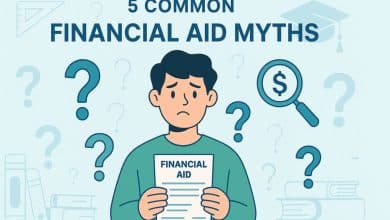Navigating Financial Aid: Key Strategies for Tier 3 Region Students
For many students in Tier 3 regions, getting into higher education is tough. Economic and geographic barriers make it hard. But, financial aid can help a lot.
It not only reduces financial stress but also opens doors to education and careers. By looking into grants, scholarships, and loans made for Tier 3 students, they can get the help they need. This way, they can reach their educational goals.
Understanding Financial Aid for Tier 3 Students
Tier 3 areas have less access to education and money for school. Students here face big challenges in getting to college. Knowing about financial aid eligibility Tier 3 helps them find money for school and succeed.
Definition of Tier 3 Regions
Tier 3 places have tough economic conditions that limit school access. Schools in these areas get less money, have fewer advanced courses, and lack college advice. This makes it hard for students to find out about Tier 3 college funding options and get help.
Importance of Financial Aid
Financial aid is key for Tier 3 students. It helps pay for school and living costs. Many students need aid to go to college. It lets them focus on learning, not money worries.
Types of Financial Aid Available
There are many ways to get financial help in Tier 3 areas. These include:
- Federal Grants – Programs like the Pell Grant give money based on need, and you don’t have to pay it back.
- State Grants – Some states give extra money to help residents, based on how much you need.
- Scholarships – Many groups and schools give scholarships for good grades or special talents.
- Loans – You can borrow money from the government or private lenders to cover costs. You have to pay it back after you graduate.
Identifying Eligible Financial Aid Programs
It’s key for Tier 3 students to know about financial aid options. There are many programs to help fund education, from federal to private scholarships. Each one has its own benefits for students in Tier 3 areas.
Federal vs. State Aid Programs
Federal aid, like the Free Application for Federal Student Aid (FAFSA), is a big help in the U.S. It offers a lot of funding for students who need it. State aid programs also help, especially for Tier 3 students. Each state has its own aid, based on local economy and education goals.
Institutional Scholarships
Colleges and universities offer scholarships for students from tough backgrounds. These scholarships for Tier 3 students have their own rules, like a certain GPA or community service. Schools want to help Tier 3 students succeed by offering financial aid.
Private Scholarships and Grants
There are many private scholarships and grants for students. Nonprofit groups and foundations help Tier 3 students a lot. These scholarships are less competitive than federal grants, so more students can get them. It’s smart for students to look for grants for Tier 3 students that match their goals and achievements.
Completing the FAFSA: A Step-by-Step Guide
Completing the FAFSA is key for students, especially in Tier 3 areas looking for financial help. This form unlocks many funding options, making it a crucial step. Knowing how to fill out the FAFSA helps students get the aid they need for school.
Importance of the FAFSA
The FAFSA is the first step to get federal and state aid. For Tier 3 students, it’s a big deal. It can open doors to grants, loans, and work-study jobs. This aid is vital to help pay for school.
Key Information Required
To fill out the FAFSA right, students need to have certain info ready. This includes:
- Social Security Number
- Driver’s license number, if applicable
- Federal tax information or tax returns from the previous year
- Records of earnings such as W-2 forms or current pay stubs
- Information on savings and investments
Having this info ready makes the application process easier and less stressful.
Common Mistakes to Avoid
Many students make mistakes that can hurt their chances for aid. To do better, avoid these common errors:
- Not completing the form by the deadline.
- Omitting required information or providing inaccurate details.
- Failing to sign and submit the FAFSA.
- Forgetting to keep copies of documents submitted.
By avoiding these mistakes, students can boost their chances of getting the aid they need.
Tips for Maximizing Financial Aid Offers
To get the most out of financial aid, Tier 3 students need a smart plan. This includes doing thorough research, building a strong profile, and meeting deadlines. These steps are key to getting the financial help needed to reach educational goals.
Researching All Possible Sources
It’s important to look into all financial aid options. Tier 3 students should explore:
- Federal aid programs, such as Pell Grants and work-study.
- State scholarships for residents.
- Funding from colleges and universities.
- Private scholarships from organizations and foundations.
Building a Comprehensive Profile
A strong profile can boost financial aid chances. It should highlight academic achievements, extracurricular activities, and community service. Students should make sure their application shows their unique story and financial needs clearly.
Meeting Deadlines and Requirements
Being on time is crucial in the financial aid process. Students must watch out for application and document deadlines. Missing a deadline can mean less financial aid or lost opportunities. Keeping a calendar of important dates can help stay on track.
The Role of Community Resources
Community resources are key for Tier 3 students. They help with school challenges and finding financial aid. Local groups offer many services to help students succeed and grow.
Local Organizations Offering Support
Many groups help Tier 3 students. They provide counseling, teach about money, and more. These places are safe for students to learn about financial aid.
Educational Workshops and Events
Workshops and events teach about financial aid. They cover topics like budgeting and scholarships. Students learn how to use financial resources wisely.
Mentorship Programs
Mentorship programs are very helpful. They connect students with professionals in their interests. Mentors help set goals and inspire students to succeed.
Understanding Award Letters
Financial aid award letters are key for Tier 3 students when choosing a college. These letters outline the financial aid packages offered. It’s crucial for students to understand the terms and how to compare these packages.
Key Terms Explained
When looking at financial aid award letters, some terms are important:
- Cost of Attendance: This is the total yearly cost for college, including tuition, fees, and living expenses.
- Expected Family Contribution (EFC): This is how much the family is expected to pay for college, based on their financial information.
- Net Price: This is what the student must pay after subtracting grants and scholarships from the cost of attendance.
How to Compare Offers
Students should compare financial aid award letters carefully. Here are some things to look at:
- Check the total cost of attendance for each school.
- Look at the types of financial aid offered, like grants and loans.
- Use a chart to see how the net price compares between schools.
Making Informed Decisions
With several financial aid award letters, making a choice is easier. By analyzing the details and asking questions, students can find the best option. Understanding these points helps students choose a college and get the financial support they need.
Navigating the Appeals Process
Understanding financial aid appeals for Tier 3 students is crucial. Knowing why you appeal, the steps to take, and how to talk to financial aid offices is important. It can greatly affect your appeal’s success.
Reasons for Appeals
There are many reasons to file a financial aid appeal. Some common ones include:
- Changes in financial circumstances: Losing a job or seeing a drop in income might require an appeal.
- Special family situations: High medical bills or needing to support family members are valid reasons.
- Academic performance: A big jump in grades or unexpected academic challenges can also justify an appeal.
Steps to File an Appeal
To file a financial aid appeal, you need to prepare well. Here are the key steps:
- Collect all important documents to back up your appeal.
- Write a clear, concise appeal letter explaining your reasons.
- Submit your appeal on time, as per the financial aid office’s deadline.
Effective Communication with Financial Aid Offices
Good communication is vital during the appeals process. Students should:
- Be polite and professional in all interactions.
- Check on the appeal’s status if you haven’t heard back in a while.
- Be ready to give more information if the financial aid office asks for it.
Managing Financial Aid Wisely
Managing financial aid well is more than just getting help. It’s about planning and making smart choices. By learning to budget, understanding loan options, and staying financially savvy, students can feel confident about their money matters.
Budgeting Principles for Students
Creating a budget is key for students. Here’s how to make a good financial plan:
- First, list all your income sources, like financial aid, part-time jobs, and family support.
- Then, note down your must-have expenses, such as tuition, books, and living costs.
- Keep track of how much you spend on things you don’t really need.
- Finally, check and change your budget whenever your money situation changes.
Understanding Loan Repayment Options
For many Tier 3 students, loans help pay for school. Knowing your repayment choices can make things easier later. Here are some options to look into:
- Standard plans with fixed monthly payments.
- Income-driven plans that adjust based on how much you earn.
- Deferment options for when you’re struggling financially.
Importance of Financial Literacy
Knowing about money is crucial for Tier 3 students. Good financial skills help them:
- Make smart choices about spending and saving.
- Think carefully about investments.
- Understand the risks of borrowing money.
Long-Term Strategies for Financial Stability
To achieve financial stability, Tier 3 students need to manage their credit and finances well. They should work on building a good credit score while in school. This can help them get better loans in the future. There are also loan forgiveness programs for students in certain fields, which can reduce debt.
After graduation, careful planning is key to keeping finances healthy. This includes managing loans and finding ways to increase income.
Building a Good Credit Score
A good credit score is essential for Tier 3 students. It helps in getting loans and can lead to lower interest rates. Here are some tips to build a strong credit history:
- Open a student credit card and pay off the balance regularly.
- Always pay bills on time, including utilities and rent.
- Check your credit reports often for errors.
Understanding Loan Forgiveness Programs
Loan forgiveness programs can help Tier 3 students a lot. Many programs, especially for public service or education, offer to forgive student loans after a certain time. Students should look into these programs and see if they qualify.
Planning for Post-Graduation Finances
Planning finances after graduation is crucial. Students should make a budget that includes income, expenses, and loan payments. Here are some tips:
- Start an emergency fund for unexpected costs.
- Pay off high-interest debt first to save money.
- Look for different ways to make money to improve financial security.
Leveraging Local and State Resources
Students from Tier 3 areas have access to many local and state resources. These can greatly help with their financial aid needs. By understanding these options, students can find state-specific programs that help with college costs.
These programs often add to the federal aid, giving more money for education. This extra funding can really help students financially.
State-Specific Financial Aid Programs
Each state has its own financial aid programs for residents. These include grants, scholarships, and loan forgiveness for Tier 3 students. For example, California and New York have programs to make college more accessible.
These programs ensure local students get the funding they need. It’s based on their financial situation.
Utilizing Local Libraries and Community Centers
Local libraries and community centers are great for finding financial aid. They offer free workshops and materials on financial aid. Students can learn about scholarships and grants they might not know about.
Visiting these places often can really help. It’s a good way to get advice on financial aid.
Seeking Guidance from School Counselors
School counselors are key in helping students with financial aid. They know a lot about local and state resources. They can guide students through their options and help with applications.
This way, students have a better chance of getting financial support. School counselors are there to help every step of the way.
Addressing Unique Challenges for Tier 3 Students
The path for Tier 3 students is filled with obstacles that block their way to education and career growth. It’s key to know these challenges to find ways to help these students. This way, they can do well in school and their future careers.
Economic Barriers and Solutions
Economic struggles are a big hurdle for Tier 3 students. Many come from poor families that can’t afford school costs like tuition and books. Scholarships and grants for low-income students can help ease this burden.
Community groups and nonprofits offer free tutoring and grants. These help students deal with their financial issues.
Access to Technology and Resources
Not having technology is a big problem for Tier 3 students. Without internet or computers, they can’t do homework or research. Schools and local governments can help by offering places to study or lending out devices.
Working with tech companies can also get students cheaper or free tech. This is a big help for those without access.
Strategies for Navigating Rural Education Systems
Students in rural areas face special challenges. Being far from cities means less access to good schools and activities. Mentorship programs can link students with professionals, offering advice and motivation.
Online learning platforms also help. They let students learn more than what’s available locally. This opens up new opportunities for them.
Case Studies of Successful Tier 3 Students
This section shares amazing success stories of Tier 3 students. They faced big challenges but got financial aid and reached their educational goals. Their stories show how hard work and the right help can lead to success.
Personal Stories of Overcoming Challenges
Many Tier 3 students deal with tough economic situations and lack of resources. For example, a student from a rural area got help from local scholarships for low-income families. This greatly reduced her financial worries.
Another student found valuable tips by connecting with peers online. They shared their experiences, helping each other succeed. These stories prove that with determination, anyone can achieve their goals.
Key Strategies Implemented
Successful students used several key strategies. They did thorough research on financial aid and talked a lot with financial aid offices. They also went to workshops to learn more about the financial world.
Many students also networked, finding scholarships and grants that weren’t well-known. This shows how important it is to work together and get support from the community.
Lessons Learned for Future Applicants
The success of Tier 3 students teaches us important lessons. First, start early because the financial aid process takes time. Second, being organized and meeting deadlines is crucial for success.
Lastly, these students emphasize the need for resilience. The journey may seem tough, but never give up and always ask for help. These lessons remind us that financial aid can make education possible for everyone.
FAQ
What is financial aid for Tier 3 students?
How can Tier 3 students apply for financial assistance?
What types of grants are available for Tier 3 students?
Are scholarships available specifically for Tier 3 students?
How do Tier 3 students determine their financial aid eligibility?
What are the best funding options for Tier 3 college students?
What should Tier 3 students be cautious about when it comes to student loans?
Can community resources assist Tier 3 students with financial aid?
Published on: 28 de March de 2025

Luke Martin
Luke Martin, author of Credwallets.com, is a mathematics graduate with a specialization in financial markets. Known for his love of pets and his passion for sharing knowledge, Luke created the site to provide valuable insights into the complexities of the financial world. His approachable style and dedication to helping others make informed financial decisions make his work accessible to all, whether they're new to finance or seasoned investors.







